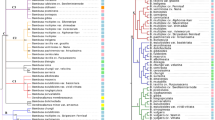Abstract
Estimates of the phylogenetic relationships among cultivated and wildAllium species would benefit from identification of objective molecular characters. Restriction fragment length polymorphisms in the nuclear 45s ribosomal DNA (rDNA) were identified among two of five accessions of each of six cultivated Alliums. Restriction enzyme sites forBamHI,DraI,EcoRI,EcoRV,SacI, andXbaI were mapped. Different lengths of the rDNA repeat unit among the cultivated Alliums were due to sizes of the intergenic spacer. Nineteen polymorphic restriction enzyme sites were discovered and used to estimate phylogenetic relationships. Cladistic analyses based on Wagner parsimony were completed without an outgroup and resulted in two equally most parsimonious trees of 22 steps. A combined analysis of differences at RE sites in the ribosomal (19 characters) and chloroplast (15 characters) DNA generated a single most parsimonious tree of 39 steps. Single trichotomies were observed at 40 and 41 steps. Strict consensus of the three trees of 41 or fewer steps consisted of a lineage forA. tuberosum, a second forA. ampeloprasum andA. sativum, and a third forA. cepa, A. fistulosum, andA. schoenoprasum. Estimates of phylogenetic relationships based on variability at restriction enzyme sites in the rDNA and chloroplast DNA agree with the classification scheme ofTraub. Because of the predominance of autapomorphies, restriction enzyme analysis of the nuclear 45s rDNA is of limited use in estimating phylogenies amongAllium sections. However it is useful in the establishment of interspecific hybridity.
Similar content being viewed by others
References
Appels, R., Honeycutt, R., 1986: rDNA: evolution over a billion years. — InDutta, S., (Ed.): DNA Systematics II. Plants, pp. 81–135. — Boca Raton, FL: CRC Press.
Coley-Smith, J., Esler, J., 1983: Infection of cultivars on onion, leek, garlic, andAllium fistulosum bySclerotium cepivorum. — Pl. Path.32: 373–376.
El-Gadi, A., Elkington, T., 1975: Comparison of the Giemsa c-band karyotypes and the relationships ofAllium cepa, A. fistulosum, andA. galanthum. — Chromosoma51: 19–23.
Ellis, P., Eckenrode, C., 1979: Factors influencing resistance inAllium sp. to onion maggot. — Bull. Entomol. Soc. Amer.25: 151–153.
Emsweller, S., Jones, H., 1935: An interspecific hybrid inAllium. — Hilgardia9: 265–273.
Feinberg, A., Vogelstein, B., 1983: A technique for radiolabelling DNA restriction endonuclease fragments to high specific activity. — Anal. Biochem.132: 6–13.
Felsenstein, J., 1985: Confidence limits on phylogenies: an approach using the bootstrap. — Evolution39: 783–791.
Gerlach, W., Bedbrook, J., 1979: Cloning and characterization of ribosomal RNA genes from wheat and barley. — Nucleic Acid Res.7: 1869–1885.
Gottlieb, L., 1977: Electrophoretic evidence and plant systematics. — Ann. Missouri Bot. Gard.64: 161–179.
Havey, M., 1991a: Phylogenetic relationships among cultivatedAllium species from restriction enzyme analysis of the chloroplast genome. — Theor. Appl. Genet.61: 752–757.
—, 1991b: Molecular characterization of the interspecific origin of viviparous onion. — J. Heredity82: 501–503.
Jones, R., Rees, H., 1969: Nuclear DNA variation inAllium. — Heredity23: 591–605.
Jorgensen, R., Cluster, P., 1988: Modes and tempos in the evolution of nuclear ribosomal DNA: New characters for evolutionary studies and new markers for genetic and population studies. — Ann. Missouri Bot. Gard.75: 1238–1247.
—, 1987: Structure and variation in ribosomal RNA genes of pea. — Pl. Mol. Biol.8: 3–12.
Maeda, T., 1937: Chiasma studies inAllium fistulosum, Allium cepa, and their F1, F2 and backcross hybrids. — Japan J. Genet.13: 146–159.
Maggini, F., Garbari, F., 1977: Amounts of ribosomal DNA inAllium (Liliaceae). — Pl. Syst. Evol.128: 201–208.
—, 1981: Sequence heterogeneity of the ribosomal DNA inAllium cepa (Liliaceae). — Protoplasma108: 163–171.
—, 1978: Individual variation of the nucleolus organizer regions inAllium cepa andA. sativum. — Chromosoma66: 173–183.
Peffley, E., 1986: Evidence for chromosomal differentiation ofAllium fistulosum andA. cepa. — J. Amer. Soc. Hort. Sci.111: 126–129.
Porter, D., Jones, H., 1933: Resistance of some of the cultivated species ofAllium to pink root (Phoma terrestris). — Phytopathology23: 290–298.
Rigby, P., Dieckmann, M., Rhodes, C., Berg, P., 1977: Labelling DNA to high specific activity in vitro by nick translation with DNA Polymerase I. — J. Mol. Biol.113: 237–251.
Rogers, S., Honda, S., Bendich, A., 1986: Variation in the ribosomal RNA genes among individuals ofVicia faba. — Pl. Mol. Biol.6: 339–345.
Schaal, B., Learn, G., 1988: Ribosomal DNA variation within and among plant populations. — Ann. Missouri Bot. Gard.75: 1207–1216.
Schaffer, H., Sederoff, R., 1981: Improved estimation of DNA fragment lengths from agarose gels. — Anal. Biochem.115: 113–122.
Schubert, I., Ohle, H., Hanelt, P., 1983: Phylogenetic conclusions from Giemsa banding and NOR staining in top onions (Liliaceae). — Pl. Syst. Evol.143: 245–256.
Stearn, W., 1944: Notes on the genusAllium in the Old World. — Herbertia11: 11–37.
Sytsma, K., Schaal, B., 1985: Phylogenetics of theLisianthius skinneri (Gentianaceae) species complex in Panama utilizing DNA restriction fragment analysis. — Evolution39: 594–608.
Traub, H., 1968: The subgenera, sections and subsections ofAllium L. — Pl. Life24: 147–163.
Vvedensky, A., 1944: The genusAllium in the USSR. — Herbertia11: 65–218.
Walker, J., Jones, H., Clarke, A., 1944: Smut resistance in anAllium species hybrid. — J. Agric. Res.69: 1–8.
Wendelbo, P., 1969: New subgenera, sections and species ofAllium. — Bot. Not.122: 25–37.
White, T., Bruns, T., Lee, S., Taylor, J., 1990: Amplification and direct sequencing of fungal ribosomal RNA genes for phylogenetics. — In: PCR Protocols: A guide to methods and applications, pp. 315–322. — New York: Academic Press.
Williams, S., DeBry, R., Feder, J., 1988: A commentary of the use of ribosomal DNA in systematic studies. — Syst. Zool.37: 60–62.
Author information
Authors and Affiliations
Rights and permissions
About this article
Cite this article
Havey, M.J. Restriction enzyme analysis of the nuclear 45s ribosomal DNA of six cultivated Alliums (Alliaceae). Pl Syst Evol 181, 45–55 (1992). https://doi.org/10.1007/BF00937586
Received:
Revised:
Accepted:
Issue Date:
DOI: https://doi.org/10.1007/BF00937586




